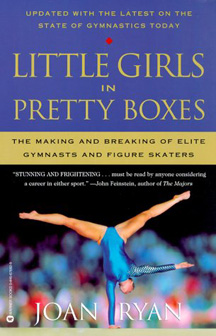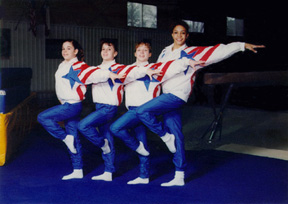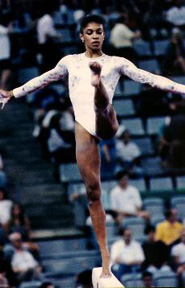 |

|
|
|
 |
 |
 |
The Balanced View:
Betty Okino
|
|
This month, Betty Okino discusses a book called "Little Girls in Pretty Boxes," in which she is featured. It's an expose of the competitive gymnastics world, as explained by a journalist. Betty now seeks to set the record straight, and explain that world through the eyes of a competitor. And the result is a column that will open everyone's eyes.
|
 |
Gymnasts: "Little girls in pretty boxes," tumbling across your television screen. Puppets on a string controlled by coaches and the gymnastics federation. Is gymnastics "celebrated child abuse"? Does the sport physically and mentally destroy young girls? If so, who is to blame?
All these questions comprise Joan Ryan's book, Little Girls in Pretty Boxes. By all means, who better to judge the rigors of elite gymnastics than a spectator? A woman with a cushy seat on the sideline, a journalist. Thanks to Joan Ryan's compelling book I have made it my duty to shed some light on this beautiful sport. Join me on a journey of elite gymnastics seen through the eyes of an athlete.
Prior to entering the Bela Karolyi camp, I knew one thing; Bela was my bus pass to the Olympics. You see, in the Karolyi gym there was a certain hierarchy, if you will. To be in Bela's core group of gymnasts, to be trained by him, meant you were one of the best. Nine of us formed his team when I first arrived -- Kerri Strug, Chelle Stack, Hillary Grivich, Kelly Pitsen, Sammy Muleman, Erica Stokes, Amy Scherr, Kim Zmeskal, and myself. But Bela liked to keep his group small -- six at the most -- so that meant a few had to go.
It sure as hell wasn't going to be me. After several weeks it became obvious how Bela was going to narrow down the team. He would push, criticize, and work us to our breaking point, and whoever remained standing earned the right to train with him.
 |
A year later, a team of nine had been narrowed down to four. Some of the girls quit the sport altogether, due to burn out. Others chose to pursue their dreams in a less competitive environment. Kerri, Hillary, Kimbo, and myself remained. Karolyi structured his training in a way that built your physical and mental strength to such a remarkable level, that even he couldn't tear you down. Bela wanted to know that when push came to shove, his athletes could handle any situation thrown at them.
If you are not an individual who thrives under intense pressure, and high physical demands, than you are foolish to believe you can handle being an elite athlete.

|
Try picturing this: You're standing on the podium at the Olympic games, staring down the end of a piece of wood that stands four feet tall, and four inches wide. You are waiting for a green light from the judge, signifying that they are ready for you to begin your routine. Over a billion eyes are on you, watching in anticipation. What are you going to do?
A well-trained athlete is going to perform one of the best routines of her life, the same way she had a million times before in practice.
One who hasn't been programmed to handle such a circumstance will drop a bomb in her leotard and run off the podium crying.
This may sound harsh, but so is the heat if you can't stand being in the kitchen. It takes a strong mind, body, and soul to play on the World and Olympic field. It is not every gymnast's destiny. (Reality check for those of you who enjoy criticizing the sport from the spectators' box.)
I was eleven years old when I started learning the Yurechenko Vault. A Yurechenko is a round-off on to the spring board, back-handspring onto the vault, then blocking off your hands to complete a salto in the air and land --the same vault that Julissa Gomez broke her neck on (the vault that eventually cost Julissa her life). News of Julissa's injury spread through the gymnastics community quickly. Gymnasts around the world, including myself, were petrified of doing the vault. Many stopped competing Yurechenkos, opting for the head-on conventional vaults.
But a taller gymnast only had to reach back with her arms to make contact for the vault, while a shorter gymnast had to jump up, then reach back -- making it the vault of choice among taller gymnasts such as myself. Although I was scared of the vault, I kept training it, until eventually I perfected it.

|
Gymnastics is a dangerous and risky sport, which requires 100% concentration and an incredible amount of self-confidence. Second guessing yourself can be fatal.
This is the case with any sport that requires air between you and the ground. Extreme sports are a perfect example. X-Games champion Dave Mira was the first to perform a double back on a BMX bike, and when the reporter asked him how in the world he pulled it off, he said he believed in himself, visualized it perfectly, and never second guessed. You either go 100%, or don't go at all. There is no middle ground when airtime is involved.
The training of an elite gymnast is structured to create a mental and physical control that cannot be broken. When you walk into an arena with over 50,000 spectators, you want the confidence of having performed your routines over and over until they flowed with mechanical ease. You want the confidence of having trained every skill to perfection, even when the soreness of injury surged through your body. In that moment when all eyes are on you, a slight lapse in confidence, or a moment of indecision could cost you serious injury, even your life.

|
Not every young girl who sets foot into a gym for the first time, has the abilities or the desire to accomplish the extraordinary in this sport. That is okay.
Gymnastics is a sport to be enjoyed by all -- for the process, not the end result. The glory doesn't come from winning medals. It comes from learning a new trick you never thought you could do; Moving up to level 9 from level 8; Acquiring a work ethic and discipline that only gymnastics can provide. There is absolutely nothing wrong with being average...
... However, when the goal is extraordinary, so is the work and sacrifice that has to go along with it.
How dare anyone call gymnastics "celebrated child abuse." Victims of child abuse aren't given a choice. We as athletes are. We should not blame the USAG, coaches, and the sport of gymnastics for turning out bitter, broken down athletes. Instead we should search for the answers a little closer to home. Those of us who came out of the sport unscarred weren't living our parent's dreams, we were living our own.
5/11/2001
Read more on Betty here.
 |
Betty Okino
1990 U.S. National Championships: Silver Medalist (AA), Gold Medalist (Beam) and Event Finalist (5th Bars, 4th Floor)
1991 World Championships: Silver Medalist (Team), Bronze Medalist (Beam) and 4th AA
1991 American Cup: Champion and Gold Medalist (AA, Vault, Bars)
1992 World Championships: Silver Medalist (Bars) and Event Finalist (8th Beam)
1992 Olympics: Bronze Medalist (Team) and Event Finalist (6th Beam)
|
|
|
|
|
 | |
|